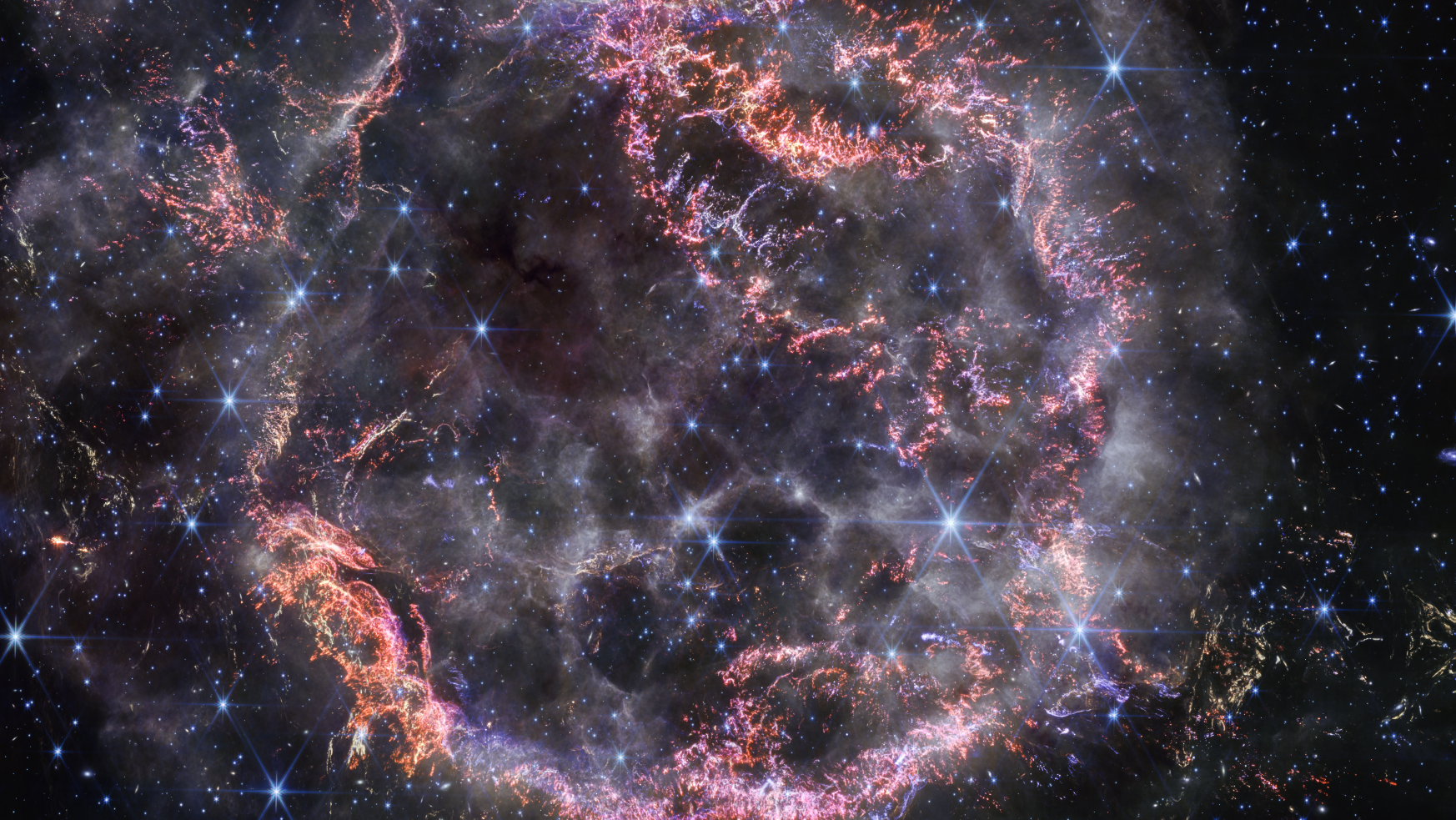
And you thought the wreckage of Christmas dinner took a while to clear up. A newly revealed image of Cassiopeia A (Cas A), taken by the James Webb Space Telescope (JWST), shows the brilliant supernova wreckage still shining like a cosmic Christmas bauble around 340 years after a star violently exploded to create it.
The image of the supernova remnant, which is located around 10,000 light-years away from us, was revealed as part of the 2023 Holidays at the White House celebration and the first-ever White House Advent Calendar by First Lady Dr. Jill Biden and NASA on Sunday (Dec. 10).
This supernova debris has previously been studied in great detail over a range of wavelengths, but the James Webb Space Telescope's new image represents "Christmas come early" for astronomers because it shows Cas A — which is about 10 light-years wide — in high-resolution. And, as the JWST's specialty goes, the image was constructed with infrared wavelength data.

"With NIRCam’s resolution, we can now see how the dying star absolutely shattered when it exploded, leaving filaments akin to tiny shards of glass behind," Purdue University scientist Danny Milisavljevic said in a statement, referring to the JWST's Near-Infrared Camera. "It's really unbelievable after all these years studying Cas A to now resolve those details, which are providing us with transformational insight into how this star exploded."
Related: James Webb Space Telescope pierces through dust to find an ancient ghostly galaxy

The image captured by the JWST's NIRCam follows up on another image taken of Cas A, a portrait that owes itself to another of the telescope's instruments, the Mid-Infrared Instrument (MIRI).This view, taken in April, showed new and unexpected features in the expanding shell of stellar debris. The weird thing, however, is that many of these features are not visible in the JWST's new image, laying out a Christmas mystery for astronomers.
In theory, these features could be absent in this new image — which also appears less colorful than the earlier picture of Cas A — because different colors were assigned to different wavelengths of infrared light in the two images. That means that each of the colors indicates a different physical process occurring in the shell of stellar material.
The most visible colors in the NIRCam image are bright orange and light pink, with these representing the inner shell of Cas A. Within this region are wispy knots of sulfur, oxygen, argon and neon gas that came from the star that exploded over 10,300 years ago. Because we see this wreckage as it was some 10,000 years ago, a portion of the gas and dust within will have already started to move away to birth interstellar dust clouds that will eventually collapse to birth new stars.
Also within this wreckage are filaments of dust and gas that are something like 10 billion light-years across, yet are still too small for even this ultra-powerful $10 billion telescope to resolve.
The Grinch is missing but 'Baby Cas A' is clear

The outskirts of the Cas A's main shellare visible in the image, but are represented by darker orange and red colors and appear almost as smoke billowing around the devastation of this stellar explosion. Here, the blast from the supernova is still pushing outwards, ramming into surrounding "circumstellar material" — which itself is too cool to be detected by the JWST.
The white hues in the image represent electrons being accelerated by powerful magnetic fields to near-light speeds and emitting a form of radiation called synchrotron radiation. This form of radiation is also forming the bubble-like structures we see in the lower half of the inner cavity.
One stunning feature of Cas A that is conspicuous by its absence in the NIRCam image is the "green monster" — a Grinch-like loop of green light scientists expect to see at the heart of the wreckage's inner shell. The so-called monster seen in the April MIRI observations of the supernova wreckage, though, which has led researchers to describe its existence as challenging to explain. However, antisocial, like the Seuss creation, the green monster's leftovers that are still visible in this image could still help explain the situation.
Circular holes that appeared in the MIRI image can be made out in this NIRCam image, manifesting as white and purple emissions that represent ionized gas formed as stellar debris forces its way through the outer gas and ultimately shapes it.
One fascinating new feature seen by NIRCam is a blob of gas and dust that researchers have named "Baby Cas A." This name is fitting because the spot of matter appears to be the offspring of the main supernova wreckage, or rather light from the explosion that is being reflected from warm dust that glows as it cools. Located around 170 light-years behind Cas A, Baby Cas A is likely to be an object of great fascination to astronomers because of its intricate dust patterns.
The NIRCam image also shows that Cas A is surrounded by other light echo "offspring" of the main stellar explosion — perhaps we're soon to investigate other baubles on the JWST's incomprehensibly large cosmic Christmas tree.







